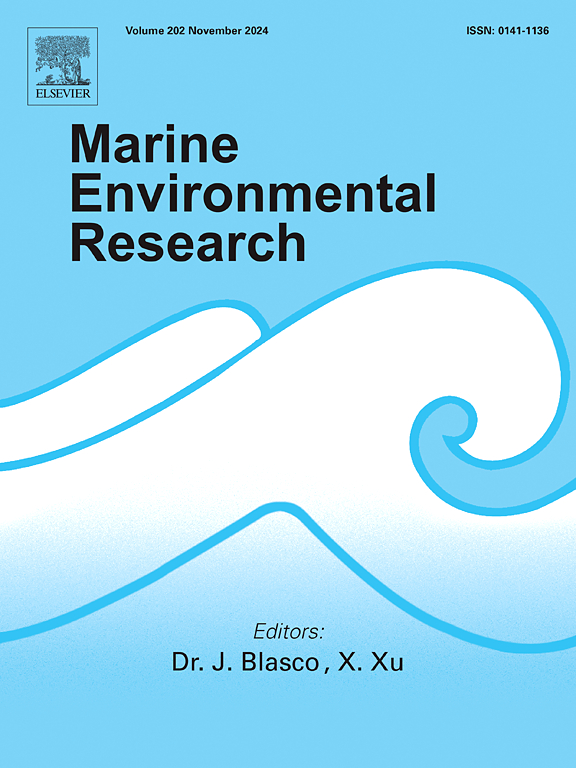Evaluating non-stationary impacts of climate and environmental conditions on Argentine shortfin squid (Illex argentinus) in the southwest Atlantic Ocean
IF 3.2
3区 环境科学与生态学
Q2 ENVIRONMENTAL SCIENCES
引用次数: 0
Abstract
Growing evidence highlights non-stationarity in climate-ecosystem relationships, suggesting that traditional analyses assuming stationarity may inadequately capture the dynamic responses of marine species to climate change. The Argentine shortfin squid (Illex argentinus), a key economic species in the southwest Atlantic Ocean (SWAO), is highly sensitive to environmental variability. This study investigated the changes in I. argentinus catch in the Patagonian Shelf region of the SWAO in response to climate variability and characterized its non-stationary features. We used a Threshold Generalized Additive Model (TGAM) and key environmental and climate variables to identify threshold years in the climate-catch relationship for I. argentinus. Results revealed significant non-stationarity with two critical thresholds: 1990/1991 and 2015/2016. In the late 1980s, the climate-regulated Weddell Sea Ice Extent (WSIE) underwent a regime shift, concurrently with long-term average states of its associated Southern Ocean environmental variables—sea surface height (SSH) and water temperatures at 50m and 100m depths. This coincided with an abrupt increase in I. argentinus catch, marking the onset of the first threshold year. In the second threshold year, WSIE and Sea Surface Temperature (SST) simultaneously transitioned to new states, accompanied by anomalous fluctuations in the critical influencing variable SSH. These changes adversely affected I. argentinus, leading to a sustained decline in catch. Research indicates that, even when excluding fishing efforts, climate-driven environmental non-stationarity is a crucial factor influencing the fluctuations in I. argentinus catch. Understanding these non-stationary dynamics is essential for robust sustainable fisheries management under persistent fishing pressure and climate change.
评估气候和环境条件对西南大西洋阿根廷短鳍鱿鱼的非平稳影响。
越来越多的证据强调了气候-生态系统关系的非平稳性,这表明假设平稳性的传统分析可能无法充分捕捉海洋物种对气候变化的动态响应。阿根廷短鳍鱿鱼(Illex argentinus)是西南大西洋(SWAO)的重要经济物种,对环境变化高度敏感。本文研究了西南海带巴塔哥尼亚陆架地区阿根廷鱼捕鱼量对气候变率的响应,并对其非平稳特征进行了表征。利用阈值广义加性模型(TGAM)和关键环境和气候变量,确定了阿根廷瓢虫气候捕获关系的阈值年。结果显示两个临界阈值(1990/1991和2015/2016)具有显著的非平稳性。在20世纪80年代后期,气候调节的威德尔海冰范围(WSIE)经历了一个政权转变,与此同时,与之相关的南大洋环境变量——海面高度(SSH)和50米和100米深度的水温——的长期平均状态也发生了变化。与此同时,阿根廷蠓的捕获量突然增加,标志着第一个阈值年的开始。在第二个阈值年,WSIE和海温(SST)同时转变为新的状态,关键影响变量SSH也出现了异常波动。这些变化对阿根廷鱿鱼产生了不利影响,导致捕捞量持续下降。研究表明,即使不考虑捕捞努力,气候驱动的环境非平稳性也是影响阿根廷鲤捕捞量波动的关键因素。了解这些非平稳动态对于持续捕捞压力和气候变化下稳健的可持续渔业管理至关重要。
本文章由计算机程序翻译,如有差异,请以英文原文为准。
求助全文
约1分钟内获得全文
求助全文
来源期刊

Marine environmental research
环境科学-毒理学
CiteScore
5.90
自引率
3.00%
发文量
217
审稿时长
46 days
期刊介绍:
Marine Environmental Research publishes original research papers on chemical, physical, and biological interactions in the oceans and coastal waters. The journal serves as a forum for new information on biology, chemistry, and toxicology and syntheses that advance understanding of marine environmental processes.
Submission of multidisciplinary studies is encouraged. Studies that utilize experimental approaches to clarify the roles of anthropogenic and natural causes of changes in marine ecosystems are especially welcome, as are those studies that represent new developments of a theoretical or conceptual aspect of marine science. All papers published in this journal are reviewed by qualified peers prior to acceptance and publication. Examples of topics considered to be appropriate for the journal include, but are not limited to, the following:
– The extent, persistence, and consequences of change and the recovery from such change in natural marine systems
– The biochemical, physiological, and ecological consequences of contaminants to marine organisms and ecosystems
– The biogeochemistry of naturally occurring and anthropogenic substances
– Models that describe and predict the above processes
– Monitoring studies, to the extent that their results provide new information on functional processes
– Methodological papers describing improved quantitative techniques for the marine sciences.
 求助内容:
求助内容: 应助结果提醒方式:
应助结果提醒方式:


